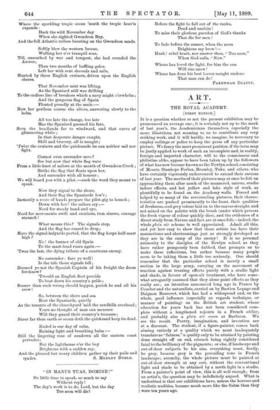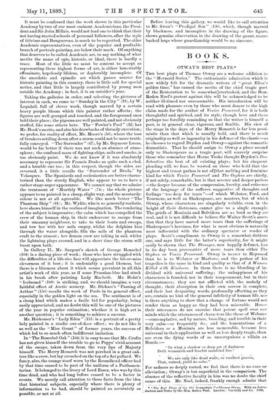ART.
THE ROYAL ACADEMY.
[FIRST NOTICE.]
IT is a question whether or not the present exhibition may be- pronounced an average one ; it is certainly not up to the mark of last year's, the Academicians themselves, especially the- more illustrious, not seeming to us to contribute any very striking work, and it will hardly, we imagine, be necessary to. employ railings or police to keep the press off any particular- picture. We fancy the most prominent position, if the term may be justly applied to work of such an incomplete and, in reality,. foreign and imported character, will to the connoisseur and philistine alike, appear to have been taken up by the followers. of what has now become known as the Newlyn school, consisting of Messrs. Stanhope Forbes, Bramley, Take, and others, who- have certainly vigorously endeavoured to extend their success' of last year. The merits of their pictures may at once be felt on approaching them after much of the mannered, untrue, studio- indoor effects, and hot yellow and lake style of work, so- plentifully to be found on the Academy walls. Forced and. helped by so many of the surrounding pictures, their charac- teristics are pushed prominently to the front, their qualities,. of freshness, cool grey colour laid on to the canvas straight, and. not mixed on the palette with the brush (under which process. the fresh vigour of colour quickly dies), and the evidences of a. direct study from Nature and fact are at once felt, —indeed, the- whole plein air scheme is well appreciated. Admit all this, and yet how easy to show that these artists too have their- mannerisms and shortcomings just as strongly developed as. they are in the camp of the enemy ! It is no persona! animosity to the disciples of the Newlyn school, as they have rather pompously been dubbed, that prompts us to. make these reflections, but rather because many people- seem to be taking them a little too seriously. One should remember that the particular school is merely a small section in the large army, carrying on the movement of reaction against treating effects purely with a studio light and shade, in favour of open-air treatment, who have some- what arrogantly assumed that they alone paint effects as they really are ; an intention announced long ago in France by Courbet and the naturalists, carried on by Bastien Lepage and Daignan Bouveret, which has had a widespread and, on the- whole, good influence (especially as regards technique, or- manner of painting) on the British art student, whose education for years back has not been considered corw- plete without a lengthened sojourn in a French atelier, and probably also a plein air cours at Barbizon. We see the result. Poetry, imagination, and invention are at a discount. The student, if a figure-painter, comes back aiming entirely at a quality which we must inadequately translate as "fatness," a quality only to be attained by painting done straight off on end, retouch being rightly considered fatal to the brilliancy of the pigments ; or else, if landscape and. out-of-door subjects be his aim, everything must, firstly, be grey, because grey is the prevailing tone in French landscape ; secondly, the whole picture must he painted at out-of-door strength at any cost, without the conventional light and shade to be obtained by a north light in a studio_ From a painter's point of view, this is all well enough ; from an artist's, the question may be indefinitely argued. What is undoubted is that our exhibitions have, minus the horrors and realistic nndities, become much more like the Salon than they were ten years ago. It must be confessed that the work shown in this particular Academy by two of our most eminent Academicians, the Presi- dent and Sir John Millais, would not lead one to think that their not having started schools of personal followers, after the style of (Jerome and Bouguereau, is much to be regretted. The older Academic representatives, even of the popular and profitable branch of portrait-painting, are below their mark. Of anything that deserves to be called Academic art, to say nothing of what merits the name of epic, historic, or ideal, there is hardly a trace. Most of the little we must be content to accept as representing these highest forms of art, is either lamentably effeminate, hopelessly lifeless, or deplorably incomplete. Of the anecdotic and episodic art which passes muster for historic painting in this country, there is little call for special notice, and that little is largely contributed by young men outside the Academy ; in fact, it is an outsider's year.
Taking the galleries in order, and selecting the pictures of interest in each, we come to "Sunday in the City" (18), by W. Logsdail, full of clever work, though marred by a certain heavy purple bloom which this painter rather affects ; the figures are well grouped and touched, and the foreground ones hold their place ; the pigeons are well painted, and not obviously stuffed, like some others here. The " Fowler's Pool" (32) has Mr. Hook's merits, and also his drawbacks of thready execution ; we prefer, for reality of effect, Mr. Moore's (50), where the toss of breakers settling down after a storm could not be more truth- fully conveyed. "The Surrender" (67), by Mr. Seymour Lucas, would be far better if there was not such an absence of atmo- sphere; the confused mass of fighting-ships, sails and smoke, is too obviously paint. We do not know if it was absolutely necessary to represent Sir Francis Drake as quite such a clod, and a humble one too ; in this respect, though the sides are reversed, it a little recalls the Surrender of Breda," by Velasquez. The Spaniards and ecclesiastics are better charac- terised than the sturdy English, who appear to us to have a rather stage-super appearance. We cannot say that we admire the treatment of " Murthly Water" (74) ; the whole picture appears to us painted in a cheap, slight way, and the mustardy- colour is not at all agreeable. We like much better "The Phantom Ship" (81) ; Mr. Wyllie, who is so generally realistic, here shows himself in the realms of imagination. The rendering of the subject is impressive ; the calm which has compelled the crew of the human ship, in their endeavour to escape from their uncanny neighbour, to take to their boats and sweeps, and tow her with her sails empty, whilst the dolphins hiss through the water alongside, fills the sails of the phantom craft to the utmost ; her demon crew are taking in sail, whilst the lightning plays around, and in a short time the storm will burst upon both.
In Gallery II., Mr. Sargent's sketch of George Henschel (104) is a daring piece of work ; those who have struggled with the difficulties of a life-size face will appreciate the hit-or-miss cleverness of it best ; it is undeniably a good likeness, but there is a blueness about it which seems prevalent in all this artist's work of this year, as if some Prussian-blue had stuck in his brush after painting Lady Macbeth. Mr. Hoist's " Icebound " (108) is striking, and, we should imagine, a very faithful effect of Arctic scenery. Mr. Dicksee's "Passing of Arthur" (150) recalls the work of Poole in its general effect, especially in the golden light on the sea. The sentiment is of a cheap kind which makes a facile bid for popularity, being easily appreciated, and no doubt this will be one of the pictures of the year in popular estimation ; whether it is high art is another question ; it is something to achieve a success.
Mr. Herkomer's "Lady Eden" (151) is a portrait of a pretty lady painted in a studio out-of-door effect ; we do not like it as well as the "Miss Grant" of former years, the success of which led to so much often indifferent imitation.
In "The Boscobel Oak" (164) it is easy to see that Mr. Crofts has not given himself the trouble to go to Pepys' vivid account of the escape, taken down from the very lips of Majesty himself. The Merry Monarch was not perched in a great oak- tree like a crow, but lay crouched on the top of a flat pollard. We fancy, also, the orange scarf worn by the Roundhead officer had by that time ceased to be part of the uniform of a Parliamen- tarian. It belonged to the livery of Lord Essex, who was by this time dead, and who had long before ceased to be a factor in events. We merely call attention to these facts from the idea that historical subjects, especially where there is plenty of information to be had, should be painted as accurately as possible, or not at all. Before leaving this gallery, we would like to call attention to Mr. Swan's "Prodigal Son" (136), which, though marred by blackness, and incomplete in the drawing of the figure, shows genuine observation in the drawing of the gaunt, razor- backed hogs whose guardianship would be no sinecure.







































 Previous page
Previous page